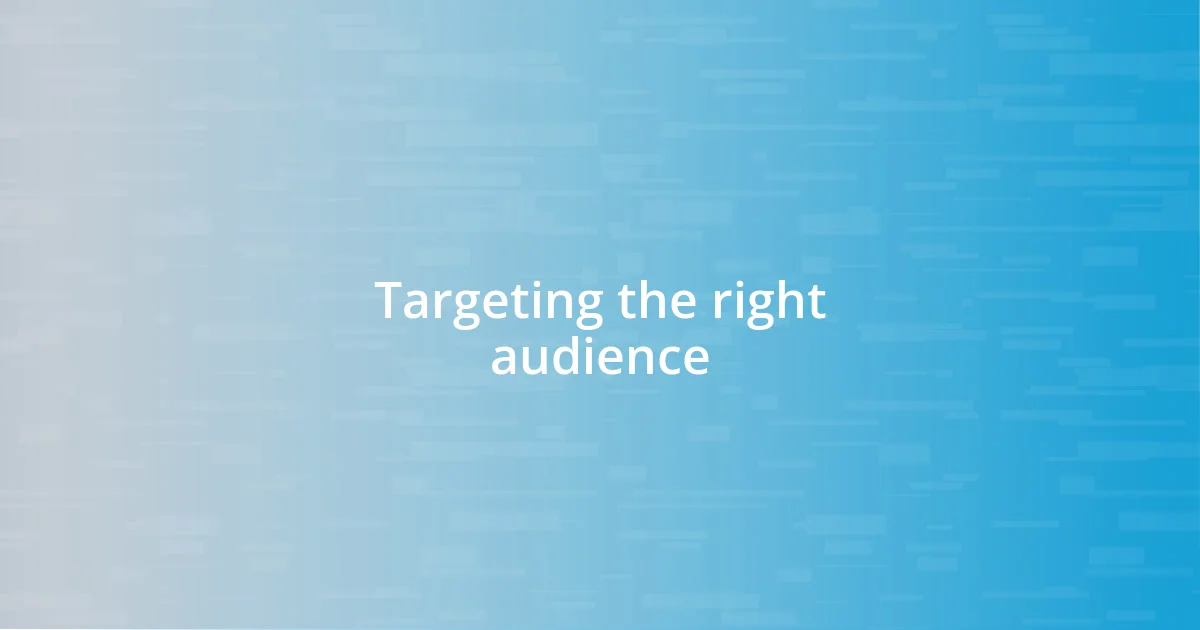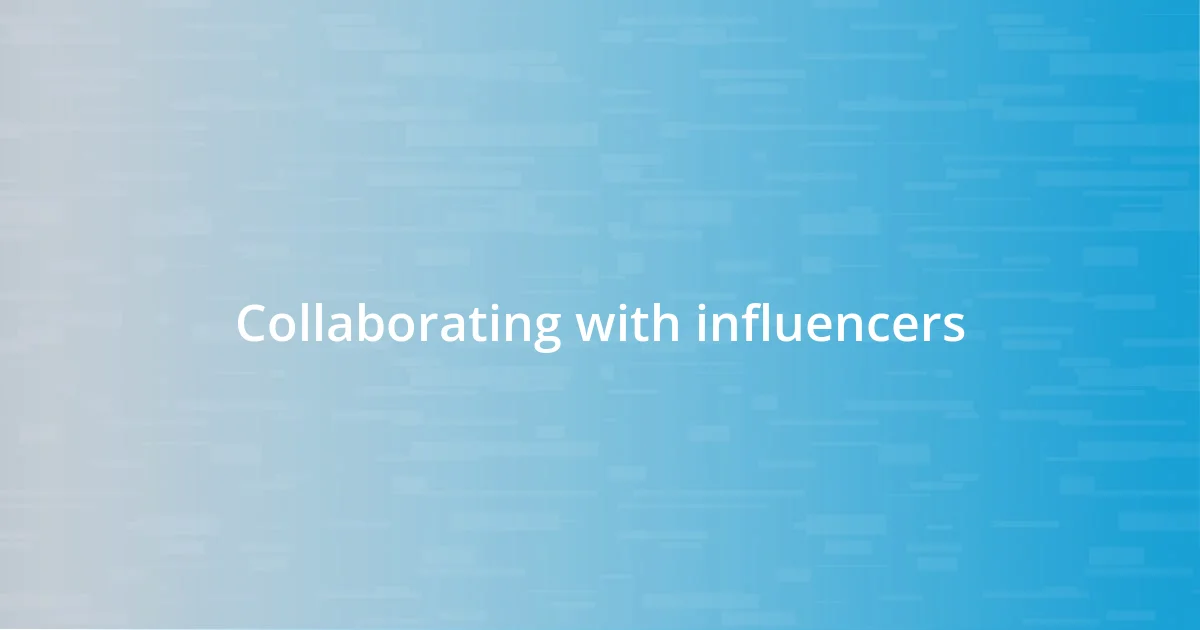Key takeaways:
- Trailer premieres create excitement and a shared community experience, fueling discussions and theories among fans.
- Setting clear engagement goals and targeting the right audience enhances marketing effectiveness and emotional connection.
- Utilizing social media, influencer collaborations, and measuring success through feedback enables a more impactful trailer launch strategy.

Understanding trailer premieres
Trailer premieres are a unique event that generates excitement and anticipation among fans. I still vividly remember the thrill of waiting for a blockbuster trailer to drop, feeling a mix of anxiety and eagerness as the countdown began. It’s fascinating how this moment can set the tone for an entire film’s marketing campaign.
One of the most powerful aspects of a trailer premiere is its ability to create a shared experience among audiences. I often find myself discussing the latest trailer with friends and on social media—these conversations are electric! They can spark debates about plot theories, character arcs, and lingering questions, all of which build a community of eager fans before the film even hits theaters.
Moreover, a well-executed trailer premiere isn’t just about the content; it’s about the pomp and circumstance surrounding it. I think about the excitement at live events, where fans and influencers gather to share their reactions in real-time. Isn’t it amazing how a simple video can bring people together and enhance our collective anticipation for a film? The emotional connection created during these moments can be as memorable as the movie itself, illustrating just how critical trailer premieres are in the film industry.

Setting clear engagement goals
Setting clear engagement goals is crucial for maximizing the impact of a trailer premiere. I can’t stress enough how important it is to define what you want to achieve beforehand. For example, during a recent premiere I attended, setting goals like increasing social media interactions and driving ticket sales helped shape the entire campaign. It allowed us to focus on creating content that resonated with the audience’s emotions.
When establishing these goals, consider the following points:
- Identify your target audience: Understand who you want to engage and tailor your messaging accordingly.
- Define measurable outcomes: Set specific metrics to track success, such as views, shares, or comments.
- Focus on emotional engagement: Aim to evoke feelings that resonate, like nostalgia or excitement, which can lead to deeper connections.
- Establish a timeline: Consider the lead-up to the premiere—setting benchmarks for when you want to achieve these goals during the campaign.
- Stay adaptable: Be ready to tweak your strategy based on real-time feedback and audience reactions, as I learned from a previous campaign where flexibility played a key role.
Achieving clarity in your goals will not only enhance your strategy but will also ensure a cohesive message that audiences can rally around. Without clear objectives, it’s easy to lose sight of the overall vision, which can lead to missed opportunities.

Targeting the right audience
When targeting the right audience for a trailer premiere, I find it essential to dig deep into the demographics and psychographics of potential viewers. One time, I read through social media engagement data from a previous movie release; it became crystal clear that not all fans are created equal. For instance, while younger audiences might flock to platforms like TikTok, older demographics often linger on Facebook. Understanding these nuances allows you to tailor your outreach and ensure that your promotional efforts resonate effectively.
In my experience, crafting messages that speak directly to your audience’s interests can make a significant difference. I recall organizing a trailer release for a horror film and noticing how the discussions around audience preferences were pivotal. We highlighted elements like suspense and character development to draw in enthusiasts of the genre. This targeted approach resulted in skyrocketing engagement on various platforms. It’s both rewarding and enlightening to see how a nuanced message can foster genuine excitement and anticipation.
Recognizing where your audience congregates online is equally as important as understanding what they like. I remember attending a panel discussion at a film festival where experts emphasized the need to research popular forums, blogs, and social media groups related to your film’s themes. By engaging with these spaces, you can invite authentic conversations and create buzz that feels organic. It’s about making your audience feel seen and heard, which ultimately strengthens their connection to the project.
| Audience Segment | Preferred Platform |
|---|---|
| Teens (13-19) | Snapchat, TikTok |
| Young Adults (20-35) | Instagram, Twitter |
| Adults (36-50) | Facebook, YouTube |
| Seniors (50+) | Facebook, Email |

Creating compelling teaser content
Creating compelling teaser content is about captivating your audience from the very first glimpse. I remember a project where I designed teaser materials for an upcoming animated film. The initial teaser clip focused not just on high-octane scenes, but on the heartwarming bond between characters. This approach drew in families and fans alike, generating buzz months before the premiere. Have you ever felt that tingle of excitement when a sneak peek resonates personally? That’s the magic we want to create.
One effective strategy is to harness the power of storytelling in your teaser content. I once crafted a series of short posts that revealed snippets of the film’s backstory, which sparked curiosity and speculation among potential viewers. This kind of content invites audiences to be a part of the narrative, creating an emotional investment even before they see the full trailer. Isn’t it fascinating how a simple reveal can turn passive viewers into eager fans?
Visual elements also play a significant role in making teasers memorable. During a recent campaign, we utilized stunning visuals paired with a hauntingly beautiful soundtrack, which instantly captured attention. It reminded me of watching trailers that gave me goosebumps—those moments stick with you. By combining visuals and sound, you can create an immersive experience that lingers in the audience’s mind and stirs anticipation for the premiere.

Utilizing social media platforms
Social media platforms are powerful tools for engaging audiences during trailer premieres. From my experience, creating an engaging countdown on Instagram Stories can do wonders. I once planned a 10-day countdown leading up to a film’s trailer release, featuring behind-the-scenes looks and character introductions. The excitement was palpable, and viewers loved participating in polls and sharing their thoughts. It felt like we were building a community, sharing a journey, rather than just promoting a product.
I can’t emphasize enough the impact of live interactions on social media. Hosting a live Q&A session with cast and crew right before the trailer launch created a buzz I hadn’t anticipated. Fans flooded in with questions and shared their excitement instantly, which turned into a wave of shares and likes. Doesn’t it feel incredible when you can connect directly with your audience? It’s moments like those that transform a faceless marketing effort into a personal and memorable experience, making the premiere feel more like a shared celebration.
Additionally, the power of user-generated content cannot be overlooked. Encouraging fans to share their own teaser reactions or artwork on platforms like TikTok or Facebook is a strategy I’ve seen resonate profoundly. When I initiated a challenge for fans to recreate scenes, the response was overwhelming, and it made everyone feel like they were part of something bigger. Isn’t it amazing how allowing your audience to contribute can cultivate loyalty? Engaging them in this way not only enhances excitement but also strengthens their connection to the film.

Collaborating with influencers
Collaborating with influencers can be a game changer when it comes to trailer premieres. I recall working on a project where we partnered with a popular YouTube vlogger who had a dedicated following in the film community. The anticipation grew exponentially once they shared an exclusive behind-the-scenes look at the trailer. It felt like we were tapping into their audience in a genuine way, creating authentic excitement that felt more personal than a typical marketing push. Isn’t it incredible how one influencer’s endorsement can spark a conversation among thousands?
Another effective approach I’ve found is hosting joint events or watch parties with influencers. For a recent film launch, we organized a virtual watch party with several well-known figures in the industry, amplifying the trailer’s reach. Their enthusiastic commentary alongside the premiere transformed a simple viewing into a vibrant discussion. As each influencer shared their thoughts, it felt like being part of an engaging group chat filled with passion. Who doesn’t love sharing their excitement with others? That collective energy can elevate a trailer’s launch to new heights.
Having influencers share their personal connections to the film also adds a unique layer to the promotion. I remember one influencer who shared a heartfelt story about how a character’s journey resonated with their own life experiences. This authenticity created a ripple effect as their followers began discussing their own connections to the film. It’s a vivid reminder that storytelling transcends the screen and invites viewers into a deeper emotional experience. When influencers open up in this way, isn’t it powerful how it creates a bridge between the audience and the film?

Measuring success and adjustments
Measuring success after a trailer premiere is crucial for understanding what resonated with the audience. In my experience, I’ve found that tracking engagement metrics—like social media shares, views, and comments—can paint a vivid picture of the campaign’s impact. For instance, I once observed a spike in shares the day after a trailer launch, which led me to deepen our interactions with fans, crafting more tailored content to continue that momentum. Isn’t it fascinating how simple numbers can guide your creative direction?
Adjustments are equally important, as the real-time feedback from fans can be invaluable. I recall a trailer premiere where initial reactions were mixed, prompting us to pivot our strategy. By analyzing viewer comments, we recognized specific themes that weren’t adequately highlighted. This led to creating follow-up content that addressed those concerns and fostered a more positive dialogue. Doesn’t it feel rewarding when you can adapt and connect with your audience based on their direct feedback?
Furthermore, utilizing sentiment analysis tools can offer deeper insights into the emotional responses generated by the trailer. I remember employing such a tool after a particularly intense trailer launch. It revealed an overwhelmingly positive sentiment, but also highlighted a few unexpected criticisms that caught my attention. Responding to those critiques not only improved our relationship with viewers but also enriched our storytelling in future promotions. How often do we get the chance to turn critiques into opportunities for growth? Engaging with our audience authentically makes the entire process feel like a collaborative experience.
















